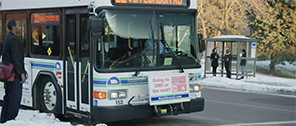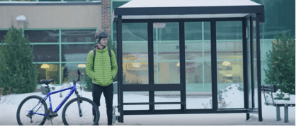Finding Your Bus Stop
The link below opens an interactive map that shows all bus stop locations for the Better Bus Blueprint service. This is designed to ensure passengers can become familiar with where each route will stop in the new system.
Use this helpful guide to learn the ins and outs of riding the bus. You can choose to read the entire guide or just the sections that apply to you. This is meant to be an easy-to-understand guide that explains the bus-riding process, making your journey as easy and enjoyable as possible.
The arrowhead Regional Development Commission (ARDC) has worked with area stakeholders to develop a “How to use the bus” booklet available Here to help guide you on your transit journey.
Welcome Aboard!
It is our privilege to serve you by providing a safe, convenient, and affordable public transit system you can depend on.
The DTA provides regular route services, along with origin destination services for disabled riders with STRIDE (Special Transit Ride) in Duluth, Proctor and Superior, Wisconsin.
Buses are equipped with accessible ramps for wheelchair riders and have “kneeling” capabilities for easy boarding. Bicycle racks are available year round, and on-board surveillance cameras provide added security for our rides and operators.
FAST FACTS
- Nearly 80 percent of Duluth and Superior residents live within walking distance of a bus stop
- The DTA operates 21 different routes
- There are approximately 1,700 bus stops and more than 100 bus shelters throughout the DTA’s service area in the Twin Ports.
If your route requires you to change buses, transfers are FREE upon request when boarding and valid on any other DTA Route for one hour after being issued. As some DTA routes are interlined with other bus routes, you sometimes have the option of staying on the same bus without transferring when the bus travels through the Duluth Transportation Center (DTC) downtown. Refer to the last “Destination” column on the time tables within each route’s passenger hand schedules for more information.
Commuting on the DTA is convenient and easy thanks to peak-hour service schedules designed to get passengers to major employment areas such as downtown, hospitals, and the mall area. Low fares and unlimited-ride fare passes make riding the DTA affordable.
Safety Policies
- Arrive at your bus stop several minutes before the scheduled time.
- Stand back 3-5 feet from the curb as your bus approaches the bus stop.
- All DTA buses are equipped with a kneeling feature to assist you with boarding and alighting.
- Have your fare payment ready before boarding.
- The bus features handrails, poles and seat handles to assist you in safely walking to your seat.
- Please take a seat when available. To ensure your safety, standing is only allowed when all seats are taken. Stand behind the yellow line.
- Please surrender your seat for senior citizens or passengers with disabilities.
- Conversations with bus operators must be trip or transit related.
- Strollers, carts and packages cannot block the aisle and must be stored under or between seats.
- Children are not allowed to remain in a stroller on the bus. They must be seated and remain under your control at all times.
- When nearing your bus stop, alert the bus operator of a “Stop Requested” by pulling the wire or pushing the button. Stay in your seat until the bus comes to a complete stop and exit out of the rear door.
- Passengers should NEVER cross in front of a DTA bus. Please wait until the bus has left the bus stop and all traffic is clear.
General Policies
- Smoking cigarettes, chewing tobacco and using e-cigarettes are not allowed on buses, in facilities or within 15 feet of any bus stop.
- Eating is not allowed on the bus.
- Drinking is allowed from a covered container.
- Respect other passengers. Keep your feet off the seats and take litter with you.
- Pets must be kept in approved animal carriers with service animals being exempt.
- The DTA enforces a zero-tolerance profanity policy. Using profanity or derogatory statements can get you removed from the bus and riding privileges canceled.
- Loud music, talking loudly on the phone and other disruptive behavior including harassment of other passengers is not allowed.
- Bicycles are not permitted inside the bus. If the bike rack is full, passengers with bicycles must take the next scheduled bus.
Boarding the Bus
HOW TO BOARD THE BUS

step 1.
Please have fare payment ready as bus approaches.
step 2.
Wait until the bus is stopped, knelt and doors are completely opened before boarding. Ask bus operator if you need the ADA ramp.
step 3.
Insert cash fare of $1.50 (Peak) or $.75 cents (Off-Peak) in top of farebox. You can also insert a Fare Card or Fare Pass in the slot on top of the farebox. Note that the quickest way to board is using your FREE DTA EZ-Card by simply tapping it on the farebox.
step 4.
Use “Three-Points of Contact” method to safely find a seat. Standing is only allowed if no seats are available.
Exiting the Bus
Exiting the BUS

step 1.
Ring the bell just before reaching your destination bus stop.
step 2.
Stay seated until the bus comes to a complete stop.
step 3.
Exit out of the back door. Only exit from the front door if ADA Ramp or Bus Kneeling features are needed.
step 4.
Wait for the bus to depart bus stop.
step 5.
Walk to the nearest crosswalk.
step 6.
Cross the street when there is clear visibility and no traffic.
Bike and Bus Services
All DTA regular-route buses are equipped year round with bike racks that accommodate up to two bicycles.
There is no additional fare to transport your bike on the DTA. However, you’ll need to wait for the next bus if the rack is full. Please note that for safety concerns, bicycles are not allowed onboard buses. Exit from the front door to inform the bus operator that you will be removing your bicycle from the rack.
“Bike & Bus” to Work on the DTA
Ride your bike down the hill to your office downtown or at the hospital. Then, easily ride the DTA back up the hill to your home.
“Bike & Bus” to Recreational Activities
The City of Duluth has recently made major investments in bicycling infrastructure across the city. Road cyclists can enjoy the Cross City Trail, the Lakewalk and the Western Waterfront Trail while mountain bikers have eight different trails to choose from including the new Duluth Traverse Trail that will span the length of city.
Bike & Bus at the DTC
The DTC provides secured storage for up to 15 bikes Keep your bike secure for only $10 a month! There is also a public bike repair station near an open-air bike rack for another 5 bicycles.
HOW TO BIKE AND BUS

Loading your bike is easy!
step 1.
Have your bike ready to load at the bus stop.
step 2.
Always load and unload your bike from the curbside.
step 3.
Lift release lever and guide rack into the down position.
step 4.
Place bike closest to bus with front wheel in the marked slot.
step 5.
Lastly, slide support arm over the front tire and board bus.
For more information, please call us:
Park and Ride
Benefits of Park and Ride:
- Less time spent in driving congestion
- No parking lot fee/expense
- Reduce road rage
- Road safety
- Environmental protection
- Efficient land use
- Community livability
Try parking at DTA’s Park and Ride lot and ride a bus to work.
Located on Calvary Road and Chicago Avenue
Route Served
112 – Woodland UMD – Mall bus route with service to downtown every half an hour during weekday peak hours and hourly during off-peak hours and weekends.